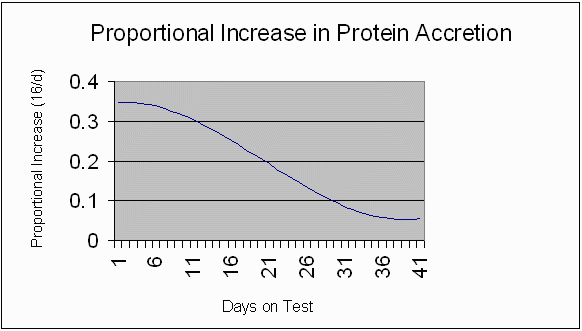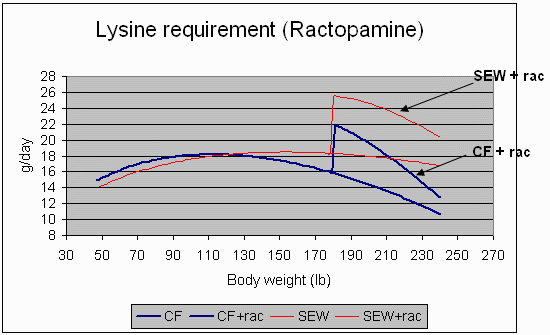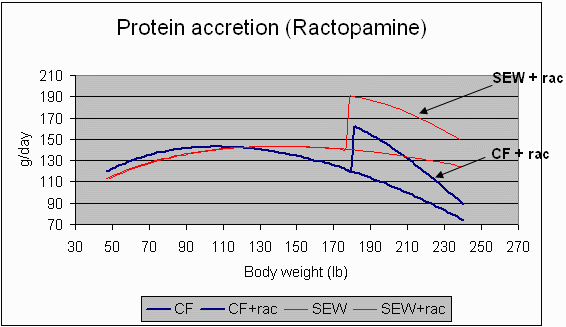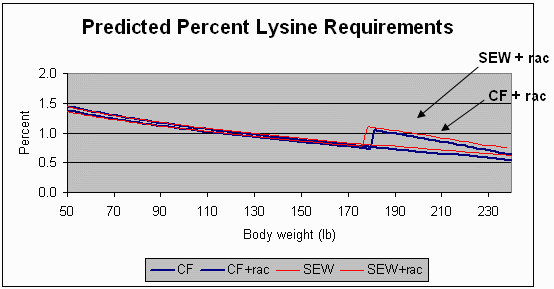
A. P. Schinckel, B. T. Richert, and D. C. Kendall
Department of Animal Sciences, Purdue University
Introduction
Pork producers have the goal to efficiently produce lean, quality pork to compete with alternative animal products. The implementation of lean value carcass pricing systems has led to the selection of pigs with increased lean growth rates, increased carcass lean percentages and improved lean feed conversion. Health, nutrition, and facility management strategies have been implemented to increase commercially achievable lean growth rates. Paylean is a feed additive that further increases the rate and efficiency of muscle tissue growth. Paylean contains ractopamine hydrochloride, a small molecule that increases muscle protein growth and improves feed efficiency. Paylean has been approved to be fed at levels of 4.5 to 18 grams per ton (5 to 20 ppm) from 150 to 240 lbs live weight (last 90 lbs of live weight gain prior to slaughter). Because of increased muscle growth and protein accretion, pigs fed Paylean have increased dietary essential amino acid requirements.
The objective of this research was to utilize recent Paylean research and develop a model of dietary lysine requirements for Paylean-fed pigs. The majority of past research trials evaluated the use of ractopamine at 4.5 to 18 gram/ton levels in 16% crude protein diets for the last 90 lbs of live weight gain before marketing.
The lean growth response to ractopamine is not constant over the entire 90 lb gain feeding period. Research has been recently conducted with high lean gain terminal cross pigs fed high lysine diets. These trials indicate that the response to Paylean is immediate and substantial the first week of Paylean feeding and then decreases.
Modeling the Paylean Response
Five parameters were taken into account when modeling the effects of Paylean.
A 24% increase in daily empty body protein accretion over the last 90 lbs of live weight gain was assumed. Recent research indicates that current high lean pigs have a greater relative response to lower levels of Paylean (4.5 to 9.0 g/ton) in comparison to the maximal 18.0 g/ton level than pigs of a decade ago. The percent increase in daily protein accretion was modeled as 24 (PL/18).228 where PL is the level of Paylean (g/ton).
The ractopamine response (RR) was modeled to describe the immediate increase and subsequent decline in the protein accretion on Paylean as a function of live weight gain. The function was derived from the observed weekly increase in growth rate and feed efficiency observed in barrows and gilts.
The reduction in feed intake was modeled as .040 (PL/18).7 times the feed intake at each live weight. This reduction in feed intake is supported by recent research trials.
The lysine content of the empty body protein accretion was modeled to increase with Paylean. Paylean increases muscle protein growth, which contains 9% lysine. Past research has found the empty body protein of pigs to contain 6.8 % lysine. Based on the approximate 12% increase in the ratio of fat free lean to empty body gain, the lysine content of the protein accretion was modeled as [.068 + (.002 RR * (PL/18).228)].
Lysine requirements were predicted for gilts reared in two environments: (1) segregated early weaning (SEW) high health management in modern facilities, and (2) an older continuous flow (CF) facility (Kendall et al., 2000). The Paylean response was modeled for the 9 g/ton level of Paylean from 180 to 240 lbs live weight (Figure 2).
The model assumes a constant percentage increase in protein accretion. Thus, the Paylean response is greater at the heavier weights in the SEW environment. The predicted grams of dietary lysine are higher for gilts fed Paylean and gilts in the SEW environment after 180 lbs live weight (Figure 3). The predicted percent lysine was similar for gilts in the two environments. The increased daily lysine requirement of the SEW gilts was partially offset by their higher feed intakes, such that the SEW and CF gilts had similar percent lysine requirements (Table 1). In general, gilts fed in the SEW environment still required a .05% total lysine increase above that of the continuous flow gilts fed the same Paylean level.
The predicted percent lysine requirement for pigs fed 9 g/ton Paylean rapidly increases during the first week of feeding Paylean, and then declines (Table 1). Phase feeding will be required if the lysine requirements are to be closely met. If the average predicted lysine requirement is fed, pigs will not achieve the maximum performance during the first week of Paylean feeding, the period of peak potential Paylean response. Also, lysine will be overfed during the period of decreased Paylean response, weeks three and four.
The model can predict the weekly lysine requirements for feeding different levels of Paylean. The maximal increase in dietary lysine percentage is 42% for gilts fed 9 g/ton Paylean and 35% for pigs fed 4.5 g/ton Paylean (Figure 4). The model indicates that producers should consider phase feeding with 2 or 3 diets of different % lysine with either the 4.5 or 9 g/ton levels of Paylean.
Implications
Paylean can substantially improve the rate and efficiency of lean growth. Producers should consider phase feeding diets higher in percent lysine than typically fed to finishing pigs.
Reference
Kendall, D. C., B. T. Richert, T. E. Weber, K. A. Bowers, S. A. DeCamp, A. P. Schinckel, and P. Matzat. 2000. Evaluation of pig genotype, strategic use of antibiotics and grow-finish management effects on lean growth rate and carcass characteristics. Purdue University Swine Day Report. p. 60.
Table 1. Predicting weekly lysine requirements for three levels of Paylean (ppm) in two environments
|
Continuous Flow |
SEW High Health |
|||||||||
|
Level of Paylean |
0 |
4.5 |
% increase |
9.0 |
% increase |
0 |
4.5 |
% increase |
9.0 |
% increase |
|
Week 1 |
.72 |
.97 |
34.6 |
1.02 |
41.9 |
.76 |
1.02 |
35.1 |
1.08 |
42.4 |
|
2 |
.67 |
.90 |
33.2 |
.94 |
40.2 |
.71 |
.95 |
33.4 |
1.00 |
40.4 |
|
3 |
.63 |
.83 |
30.6 |
.87 |
37.1 |
.67 |
.87 |
29.7 |
.91 |
36.0 |
|
4 |
.60 |
.76 |
27.2 |
.79 |
33.0 |
.63 |
.77 |
24.7 |
.82 |
30.7 |
|
5 |
.56 |
.69 |
23.5 |
.72 |
28.6 |
|||||

Figure 1. Proportional Increase in maximum protein deposition due to ractopamine fed at 9 g/ton (10 ppm)

Figure 2. Protein accretion (g/day) for continuous flow (Baker) and SEW environments, with and without ractopamine (9 g/ton Paylean level) 180 - 240 lbs live weight

Figure 3. Lysine requirement (g/day) for continuous flow (Baker) and SEW environments, with and without ractopamine (9 g/ton or 10 ppm Paylean level)

Figure 4. Lysine requirement (%) for continuous flow (Baker) and SEW environments, with and without ractopamine